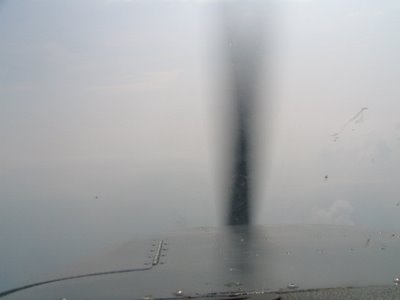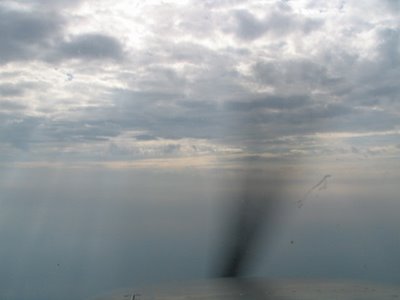GA pilots learn early on in their student pilot days - perhaps when a lesson is cancelled due to an unfavorably strong crosswind - how fickle the weather can be, and how important it is to keep your travel plans flexible. With light aircraft, it's difficult to set an agenda and stick to it regardless of what develops. Pilots who fail to heed that simple lesson can often be read about in the pages of NTSB accident reports.
With that sober thought in mind, I set off on my flying vacation.
Day 1
Cleveland, OH to Westerly, RI, 451nm
My original plan was to depart my home airport around 10am and arrive in Rhode Island around 2pm. But, the evening before departure, a check of the weather shows a cold front threatening to push its way through our neck of the woods. Late morning thunderstorms look likely to make travel in my non-Stormscope equipped 1964 Cessna 172E all but impossible. So, I set the alarm clock for 5am. I'm going to beat that weather system out of Cleveland.
I'm up at five o'clock and on the phone to Flight Service for a briefing. My plan is to get to the airport early so I can take some time in the pilot's lounge to scan the radar and satellite images. Plus I want to run my flight plan through the AOPA Flight Planner to see how much help I'm going to get from those winds aloft. Sure, I could do it by hand, but it's easier and more precise to let the computer do it for me.
As I pull into the empty parking lot at Weltzien Skypark it occurs to me I never did find out that code on the airport office's digital combination lock. So much for relaxing in the pilot's lounge with a cup of coffee as I pore over the charts.
But as luck would have it, I've conned the IT guys at my office into loaning me a cellular modem card for my laptop. Now's the perfect chance to use it. And it works like a charm. I sit in my hangar, fire up the laptop, review the weather charts, and file an electronic flight plan. Looks like I'll get quite a push from those upper winds: 3.5 hours estimated time en route. Not too shabby for a 40-year old Skyhawk.
After fueling the main and auxiliary tanks, I call the local FSS to get my clearance. Only, they don't have a flight plan for me. Seems like every time I use DUATS to file a flight plan, it doesn't go through. One of these days, I'll figure out what I'm doing wrong. So, I sit on the phone for a few minutes while the briefer gets a clearance for me. Our airport is on the border of the Cleveland and Akron terminal airspaces, so negotiating a clearance sometimes seems like an art form and always depends on which direction you depart.
Eventually, I get the following clearance: "N3978S is cleared to the Westerly State Airport via radar vectors, enter controlled airspace on a heading of 360, maintain 2000, expect 5000 ten minutes after departure . . . ." Well, how do you do, a clearance of over 400 miles via radar vectors? I expect I'll get an amendment to my clearance sooner or later.
I launch into blue skies, get radar identified and indeed am then cleared onto my course as filed, to Westerly. All goes well, especially when just inside the Pennsylvania border, I experience my first actual IFR conditions while solo. I've had my IFR ticket for a month or so, with a couple of hours of actual instrument conditions during training. But this is the real thing, and I'm all alone in the thick. Thankfully, I've been exceptionally well trained by my CFII and all goes well. Mostly, I'm in and out of the cloud tops for about 45 minutes, but it's great experience and a huge confidence booster for things to come.
Nearing the Wilkes-Barre/Scranton area, ATC starts rattling off amended clearances that route me north of the New York Class Bravo airspace. It's a crash lesson in using the flight plan function of the Garmin 430 installed in 78S last February. A couple of Victor airways that have substantial course changes in them have me bemoaning the fact that I don't have an autopilot - or at least a third arm, what with maintaining straight and level, folding charts, and trying to input waypoints into the GPS.
Then, I get cleared direct to the THUMB intersection. I can't find it for the life of me, and, wanting to make sure that it doesn't have some kind of crazy spelling, I ask the controller to spell it for me. I'm surprised when he doesn't come back with, "Look at your hand and think about it!"
Eventually, I'm cleared for the localizer approach into runway 7 at Westerly. I spot the runway from a couple miles out, cancel IFR, and circle to land on Runway 25. Dad's there waiting for me, and I've made the trip in a mere 3.5 hours. Hmmm, I wonder what kind of headwinds I'll get for the trip home.


3 comments:
I just got my IFR ticket exactly a week ago, and shuddered myself at a fly-in to an IFR training session at Camp Douglas, WI this past Saturday. I looked at the weather all day Friday and Saturday morning. On Friday, late afternoon, I emailed out to a friend in the flying club and said, "I think I'll just drive" -- it was forecasted to be BR 3SM OVC005. He said, "let's go, I'll go with". We do have 2-axis auto-pilot and that helps a lot, especially coupled to the navigation system. I'm glad I flew, I learned much and ended up popping out at 800ft about 1.2 miles from the end of the runway watching the sequenced lights.
For keypunch combination locks at airports.....
Give the unicom or tower frequency a try.
GB, I do know for a fact that the Unicom at The Home Base is not the code for the door. But I did see that at lots of the remote airports we visited during the trip to Alaska last summer.
Post a Comment